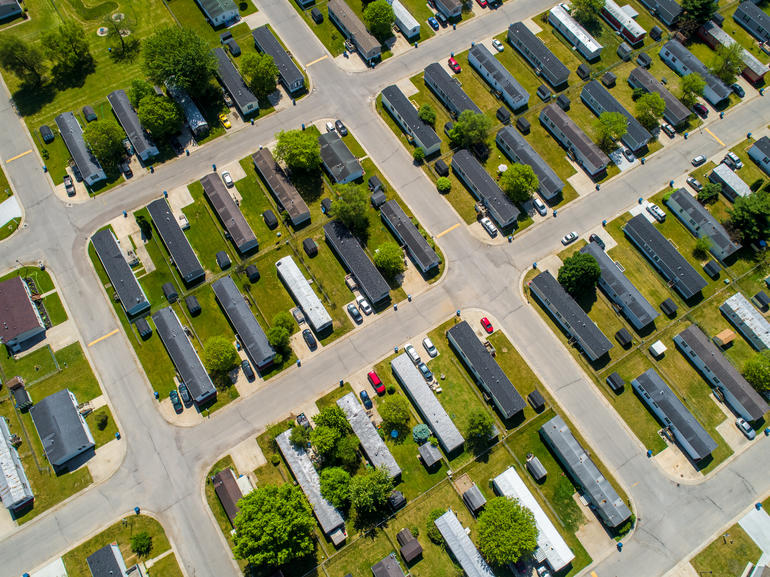Trends in the Manufactured Housing Community Sector: Unlocking Opportunities for Investors

As the wider real estate market cools, manufactured housing communities (MHCs) remain a hot asset. Demand for this type of commercial real estate (CRE) is on the rise, as are rents. Plus, occupancy and cap rates tend to be more stable than their traditional multifamily sibling. Here, we explore the latest MHC developments, including regulatory and rent control issues, as well as investment and financing trends.
General MHC Trends
The MHC market has become more institutional over the previous cycle, providing potentially lucrative opportunities for savvy investors.
A Focus on the Primary MHC Market
With a lack of five-star communities – which are equivalent to Class A in multifamily – available for sale on the market, many MHC investors have been expanding or even breaking their typical investment criteria in an effort to find deals. For instance, those who once only invested in communities with public utilities are now considering private utility deals. Financing is also driving many investment decisions. Some institutional owners are selling tertiary deals to free up capital so they can focus on the primary MHC market, where it's easier to finance. Investment sales brokers can help property owners shift their investments to the safest options, while debt brokers can secure favorable commercial loan interest rates.
Seller Financing Driving Transactions
Seller financing, where sellers are willing to “carry paper” or act as a lender to prospective buyers, is also driving transactions in the MHC sector. Sellers willing to carry paper that's 100 to 150 basis points inside market debt can yield up to 20% higher values, offering a “win-win” situation to both buyer and seller.
Non-Profits Filling Buyer Gaps
Elsewhere, non-profit groups with access to cheaper capital have filled in some of the gaps in the MHC buyer pool — a trend that will likely continue. Due to their low cost of capital, these groups tend to overbid typical investors for deals they like, but they require a much longer escrow or financing contingency, which can lead to diminishing property values if market conditions fluctuate. However, additional opportunities – such as HUD’s new grant program for MHC communities as well as state-specific property tax abatements – enable non-profits to pay more aggressive prices.
Decline of M&P Ownership
A longer-term trend is institutional owners almost eliminating mom-and-pop ownership, which has been going on for the last 15 years or so. Institutional groups over the last cycle have bought out a good portion of the M&P sector of the market, particularly larger mobile home communities with 75 or more spaces.
Occupancy Rates Increase
Other trends to note are in Northmarq's most recent Manufactured Housing report, which reveals insights about market fundamentals in the fourth quarter of 2023. While delivery of new units in the United States was consistent throughout 2023, demand for this type of housing continued to grow at above average rates. Occupancy rates accelerated by 10 basis points to reach 94.7%, with impressive gains in the Midwest and Southwest. Moreover, occupancy across the country has risen 30 basis points year-over-year.
Rent Opportunities Grow
Manufactured housing rents also show healthy signs of growth, rising 1.5% in the fourth quarter of 2023. Rents have increased by 7.3% year-over-year and now average $679 per month. In the South, rents have been trending high for the past few years and grew 10.1% in 2023, with the average manufactured home costing $655 per month.
Sales and Transaction Volume Increases, Total Transactions Decline
In other news, sales for manufactured housing communities increased during the second half of 2023 despite a slowdown at the beginning of that year. Sales volume grew by 25% from the first half to the second half of 2023. However, total transactions for the year were down 40% compared to 2022 levels.
If occupancy, rent, sales, and transaction volume continue to trend upward in 2024, investors can make significant gains from this type of commercial real estate investing.
Cap Rates
MHC cap rates have been less volatile than traditional multifamily assets over the last 18 months. That said, rates averaged 6.5% at year-end 2023, which is higher than the previous year. This might level off if or when interest rates decline. Four- and five-star park cap rates are up +/- 25 basis points from their lowest point, while three-star and fewer parks are up +/- 100 basis points. Meanwhile, cap rates for multifamily properties are up a minimum of 100 basis points and by as much as 300 basis points in some scenarios.
A lack of inventory has certainly kept rates from increasing further. However, these numbers, along with fewer MHCs being sold for conversion to other housing uses, have caused the prices of manufactured homes to decline in 2023.
With the help of experts who deal in MHC transactions, investors can find the best cap rates for manufactured home communities based on the income these properties might generate in the years to come. Doing so will help to reduce risk in a fluctuating market.
It's worth noting that investors have benefited from tax advantages when investing in MHCs, thanks to recent rapid depreciation laws. The Tax Cuts and Jobs Act (TCJA) allowed investors to write off 100% of the cost of eligible property acquired and placed in service between September 27, 2017 and January 1, 2023. Previously, they could only write off 50%. It's no wonder, then, that MHCs have recently been a highly sought-after CRE asset. Current investors, of course, won't be able to access such generous provisions, with qualifying properties only getting a 60% bonus deduction in 2024 and even less in future years.
Regulations, Rent Control Issues, and Other Challenges
Another obstacle facing current investors is potential new rent control laws, with long-term owners of manufactured homes believing it's only a matter of time before rent caps become a reality across the country. What eventually happens depends on individual states. In Oregon, lawmakers are hashing out regulations that could impact revenue generation for investors. Many long-term owners and would-be buyers are in limbo until the government decides whether to impose new rules.
Purchasing MHCs in neighboring states that are more business-friendly could provide a solution for Oregon investors for now. However, constant uncertainty might sway them to place their money into another commercial real estate investment or renegotiate a commercial real estate loan.
Elsewhere, other regulatory issues have made activities like investing in mobile home parks more difficult. For example, in Colorado, sellers of a mobile home park must notify mobile homeowners about a proposed sale. Tenants can also submit a competing offer to purchase the park.
Other challenges for MHC investors are similar to those impacting the wider real estate market. Costs for construction, insurance, labor, and supplies have increased dramatically over the last few years because of inflation and the cost-of-living crisis. Supply chain issues have also made it difficult to build or expand manufactured housing communities. While these problems are improving — CPI inflation fell 3.1 percentage points from 6.5% in December 2022 to 3.4% in December 2023 — high property taxes and insurance costs mean some investors have shunned real estate assets entirely.
Financing Trends
Government Sponsored Enterprises (“GSEs” or “the Agencies”) are still the preferred lender for most MHC investors. The mission of the Agencies is to finance workforce housing, and MHCs squarely meet that goal. MHC deals tend to score very high on an affordability test which allows both Fannie Mae and Freddie Mac to tighten up their pricing, making them the most aggressive lender available for the product type. If an investor is looking for maximum leverage and interest-only at the most competitive pricing, the deal is almost guaranteed to go to the Agencies.
For long-term owners that are looking to put conservative debt on a property, we see the life insurance companies be very aggressive for the right deals. For institutional quality parks, where owners are only looking to put +/-50% LTV on the property, the life companies can at times price more aggressively than the Agencies. Life companies tend to be very selective on the deals they like but when they decide a deal fits their credit box, they can typically stretch more than anyone to win a deal.
Banks and credit unions tend to fill the bottom end of the spectrum for MHCs. They are willing to lend on the smaller parks and lower-end parks. These lenders are not typically the cheapest and most are recourse, but there are a number of banks and credit unions that specialize in the space and understand the product type well.
A Look to the Future
Manufactured housing has proved to be a profitable CRE property type in 2023, and the MHC market will likely continue to prosper in 2024 and beyond. While other real estate segments face challenges, MHCs have experienced healthy occupancies, sales, rents, and transaction volumes, making these assets highly sought after by investors.
While regulatory and rent control issues could hamper growth, MHC cap rates have been less volatile than multifamily properties in the last 18 months, and a lack of inventory has kept rates from spiraling upward — trends that could continue for the time being. Investors might be disappointed that tax advantages aren't as lucrative as before 2023. However, a wide range of financing options on the market makes it easier than ever to fund this type of investment.
Whatever the future holds, MHC transactions will increase as more investors look to this real estate type to add value to their portfolios.
Read More
Insights
Research to help you make knowledgeable investment decisions



